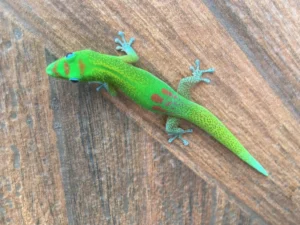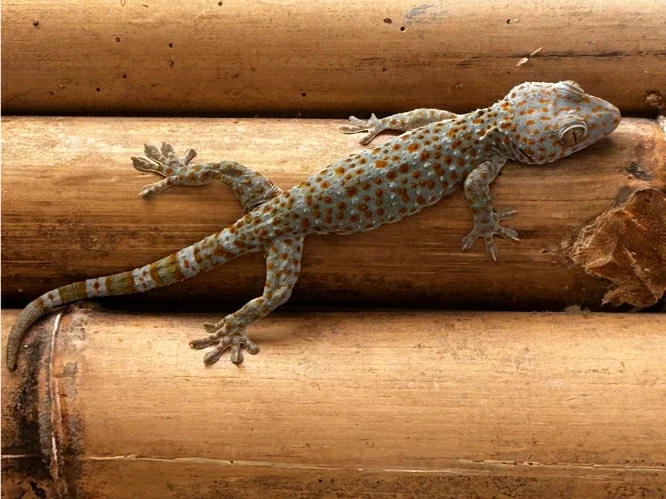It’s a quiet evening and you spot a pair of geckos. Then suddenly, one lunges at the other, and you might wonder: can they actually kill each other?
Most of the time, geckos don’t kill each other. Fighting to the death is really rare in the wild. Instead, geckos use a mix of intimidation, body gestures, and sometimes minor biting to sort out disputes, usually over territory, food, or mates.
But under certain circumstances, especially in captivity, conflicts can get more serious, sometimes leaving geckos injured or, in very rare cases, dead.
Many Gecko Species Are Territorial
In the wild, geckos mostly live alone.
Imagine a sun-drenched rocky outcrop. A male gecko has claimed a small crevice as his own space.
He knows every crack, every shadow, every place an insect might hide. Another male wanders too close, maybe looking for a mate or just passing through.

The first male doesn’t attack right away. He arches his back a little, puffs up, and twitches his tail. The intruder stops, sizing up the situation.
They bob their heads, watching each other. This dance can last several minutes, with each gecko deciding if it’s worth the risk.
Most of the time, the intruder backs off. Killing over territory is rare because even a small injury could leave a gecko open to predators.
Nature teaches them restraint. Staying alive matters more than winning every fight.
Even in species considered territorial, like Tokay geckos, fights are about showing dominance, not killing. These geckos have strong jaws and bold personalities.

They’ll chase or bite rivals, but lethal attacks are rare. Their battles are careful and calculated, like a poker game where one wrong move could cost them their life.
The Mating Season Makes Geckos More Competitive
Mating season adds another layer of tension. Male geckos get more assertive, competing for female attention.
In the dense rainforests of Madagascar, male day geckos might sprint across branches, chasing rivals while sending signals to females with bright, vibrating tail movements.

These displays can look chaotic. Rival males might collide, bite at tails, or wrestle briefly. But death isn’t the goal. The point is to show dominance and get a mate without taking unnecessary risks.
Female geckos play a role too. Some may resist a male’s advances, which can trigger chases or minor bites.
These interactions are rarely fatal, they’re more about signaling and negotiation than outright combat.
Life in Captivity: When Fights Can Escalate
Things can get more intense in captivity. In a terrarium, space is limited, hiding spots are few, and geckos can’t run away like they would in the wild.
Imagine three male leopard geckos in a medium tank. At first, everything seems calm. But soon, one male started asserting dominance.

He chases the others relentlessly, nipping at tails and corners, leaving tiny scratches. The squabbles last several days.
The geckos get stressed, eat less, and move restlessly. No gecko dies, but two have noticeable injuries. Separating them calms things, and within a week, all three start eating normally again.
Fights in captivity are rarely about killing. They’re about stress, limited space, and competition. Without room to escape, conflicts can get more serious than they would in the wild.
How Do Geckos Communicate Aggression?
Geckos have plenty of ways to settle disputes without serious harm. Before any real contact happens, they use body language, tail movements, and sounds.
-
Tail-waving or twitching: This is a warning. “Back off, or I’ll bite.”
-
Head-bobbing: Shows confidence and size.
-
Chasing or lunging: Mostly meant to scare, not hurt.
-
Biting: Usually targets tails or limbs, causing minor injuries.
-
Tail-dropping: If things get intense, some geckos can drop their tail as a distraction, giving them a chance to escape instead of fighting to the death.
How Aggressive Are Different Gecko Species?
Different geckos have different temperaments. Some are naturally feisty, others are more laid-back. Here’s a look at how aggression varies in 8 common gecko species:
| Gecko Species | Aggression Level | Notes on Behavior |
|---|---|---|
| Leopard Gecko | Low | Pretty calm, easy to handle, usually doesn’t bite. |
| Crested Gecko | Low | Shy and gentle, might nip if scared, but not mean. |
| Tokay Gecko | High | Very territorial and loud, will bite if it feels threatened. |
| Gargoyle Gecko | Low | Slow and calm, mostly just hangs out and hides. |
| Day Gecko (Phelsuma) | Medium | Busy and alert, might nip if it feels its space is being invaded. |
| House Gecko (Common) | Low | Tiny and jumpy, usually runs away instead of fighting. |
| Gold Dust Gecko | Low | Small and shy, likes to hide, not aggressive at all. |
| African Fat-Tailed Gecko | Low | Mostly relaxed, only bites if really annoyed. |
This shows that while some geckos are more likely to act aggressively, most sort out conflicts without causing serious harm. The goal is dominance, not killing.
Do Geckos Ever Get Injured During Fights?
Even when fights aren’t deadly, injuries can happen. Scrapes and bite marks are common, especially among males defending territory.
Stress is another risk. Constant fighting can weaken their immune system, reduce appetite, and slow growth.
Pet owners often notice their gecko hiding for hours, eating less, or limping slightly after a scuffle. These are usually signs of minor injury or stress.
With a safe, calm environment, geckos usually recover fully. Cleaning wounds and separating aggressive individuals can prevent further problems.
Conclusion
So, do geckos kill each other? For the most part, no. They can fight, but it’s rarely about killing.
Most disputes are over dominance, territory, or mates. Injuries can happen, especially in captivity, but geckos mainly use intimidation, displays, and minor biting to settle things.
Geckos are fascinating in how they balance aggression and survival. Tokay geckos are feisty and territorial, while crested geckos are more relaxed and social. Tail-dropping, chasing, biting, and head-bobbing are all part of a careful strategy to avoid serious harm.
In the end, geckos fight to survive, not to kill.
Hi, my name is Ezra Mushala, i have been interested animals all my life. I am the main author and editor here at snakeinformer.com.

